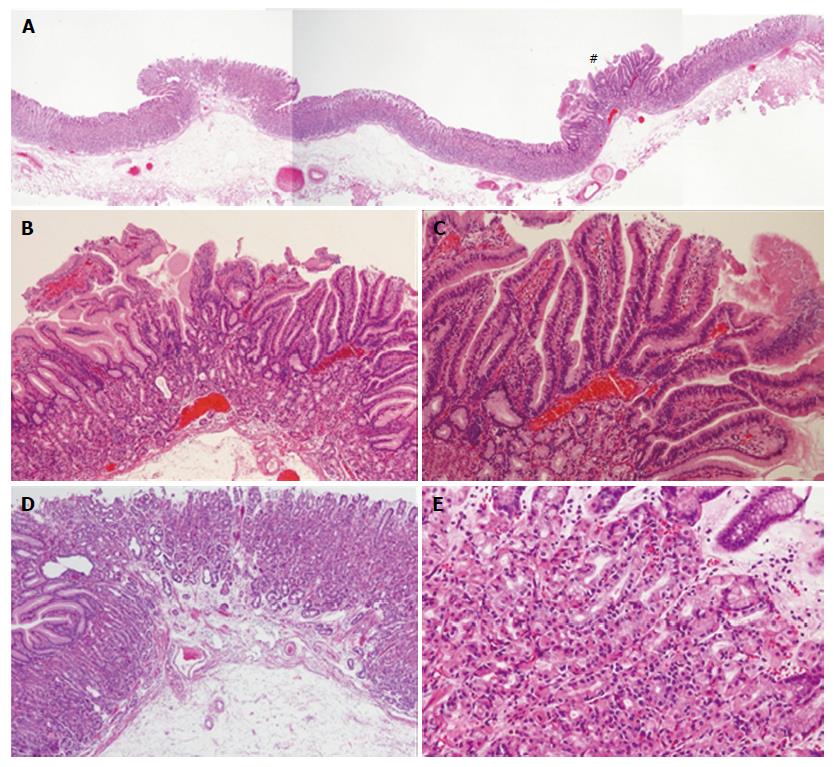Copyright
©The Author(s) 2016.
World J Gastroenterol. Oct 28, 2016; 22(40): 9028-9034
Published online Oct 28, 2016. doi: 10.3748/wjg.v22.i40.9028
Published online Oct 28, 2016. doi: 10.3748/wjg.v22.i40.9028
Figure 1 Conventional endoscopy in Case 1.
Reveals a reddish polypoid lesion adjacent to an isochromatic small polyp on the anterior wall of the upper gastric body (A). ME-NBI of the reddish polypoid lesion shows an irregular microvascular architecture composed of closed loop- or open loop-type vascular components, plus irregular microsurface structure composed of oval-type surface components with demarcation line (vessels within epithelium pattern; B); ME-NBI of the adjacent isochromatic polyp shows regularly arranged round gastric pits within regularly arranged honeycomb-like microvessels with demarcation line (epithelium within vessels pattern; C).
Figure 2 Histological examination of the endoscopic submucosal dissection specimen from Case 1.
Shows that the left side lesion (#) is consistent with reddish polypoid and the right side lesion is consistent with isochromatic small polyp (A). High magnification of the left side lesion (#) shows irregularly branching tumor glands with atypical nuclei at the surface part of the lesion, and proliferation of fundic glands with some cystic dilatation at the basal part of the lesion, which was diagnosed as very well-differentiated adenocarcinoma occurring in FGP (B and C). High magnification of the right side lesion shows proliferation of fundic glands with some cystic dilatation, which was diagnosed as FGP without dysplasia (D and E). FGP: Gastric fundic gland polyp.
Figure 3 Conventional endoscopy in Case 2.
Reveals a reddish polypoid lesion adjacent to an isochromatic small polyp on the anterior wall of the upper gastric body (A). ME-NBI of the reddish polypoid lesion shows an irregular microvascular architecture composed of closed loop- or open loop-type vascular components, plus irregular microsurface structure composed of oval-type surface components with demarcation line (vessels within epithelium pattern; B). ME-NBI of the adjacent isochromatic polyp shows regularly arranged round gastric pits within regularly arranged honeycomb-like microvessels with demarcation line (epithelium within vessels pattern; C).
Figure 4 Histological examination of the endoscopic submucosal dissection specimen from Case 2.
Shows that the right side lesion (#) is consistent with reddish polypoid and the left side lesion is consistent with isochromatic small polyp (A). High magnification of the right side lesion (#) shows irregularly branching tumor glands with atypical nuclei at the surface part of the lesion, and proliferation of fundic glands with some cystic dilatation at the basal part of the lesion, which was diagnosed as very well-differentiated adenocarcinoma occurring in fundic gland polyps (FGPs) (B and C). High magnification of the left side lesion shows proliferation of fundic glands with some cystic dilatation, which was diagnosed as FGP without dysplasia (D and E). FGP: Gastric fundic gland polyp.
- Citation: Togo K, Ueo T, Yonemasu H, Honda H, Ishida T, Tanabe H, Yao K, Iwashita A, Murakami K. Two cases of adenocarcinoma occurring in sporadic fundic gland polyps observed by magnifying endoscopy with narrow band imaging. World J Gastroenterol 2016; 22(40): 9028-9034
- URL: https://www.wjgnet.com/1007-9327/full/v22/i40/9028.htm
- DOI: https://dx.doi.org/10.3748/wjg.v22.i40.9028












